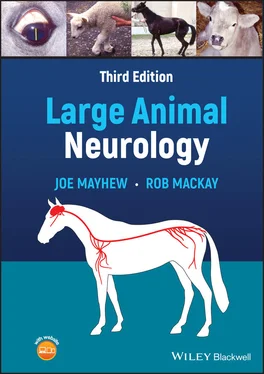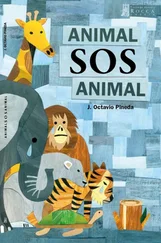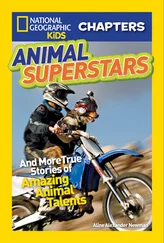9 Index
10 End User License Agreement
1 Chapter 2 Table 2.1 The following tests and criteria can be evaluated in a physical e... Table 2.2 Outline of basic format for the neurologic examination, based on ... Table 2.3 Assessment of cranial nerve function Table 2.4 Prominent gait and postural abnormalities present with neurologic... Table 2.5 Common clinical features with lesions involving central motor pat... Table 2.6 Examples of syndromes in which an organic neurologic lesion may b...
2 Chapter 31Table 31.1 Congenital, familial, and genetic disorders in calves with commo...Table 31.2 Diagnostic characteristics of the common diseases resulting in c...Table 31.3 Details of major lysosomal storage diseases of large animalsTable 31.4 A guide to differentiating five familial diseases resulting in p...
3 Chapter 32Table 32.1 Commonly reported neurologic signs in large animal rabies cases ...Table 32.2 Syndromes associated with various causes of viral encephalomyeli...Table 32.3 Overview of reported congenital malformations caused by in utero...Table 32.4 Comparison of various tests used to assist in the diagnosis of E...Table 32.5 TREATEPM‐1. A selection of drugs and their combinations used for...Table 32.6 TREATEPM‐2: Drugs and combinations approved for treatment of EPM ...
4 Chapter 33Table 33.1 Pathologic and clinical classification of traumatic brain injury...Table 33.2 Key steps in an ideal but quite logical scheme for immediate con...
5 Chapter 34Table 34.1 Examples of several poisonous plants that cause degrees of parapa...Table 34.2 Several acquired tremor syndromes affecting domestic herbivores a...
6 Chapter 35Table 35.1 Proportion of major clinical signs recorded for 104 cases of EMN...
7 Chapter 38Table 38.1 Reference table for acceptable minimal intravertebral and interv...
1 Chapter 1 Figure 1.1 Basic areas of the brain can be readily recognized on this diagra... Figure 1.2 Basic monosynaptic spinal reflex pathway (patellar reflex) showin... Figure 1.3 Central motor neuronal pathways predominantly originate in the br... Figure 1.4 Sensory pathways convey somatic, proprioceptive, and visceral inp... Figure 1.5 Important cerebellar connections include subconscious general pro... Figure 1.6 Some cranial nerves are involved with specialized modalities such... Figure 1.7 A state of alertness or consciousness is maintained by the forebr... Figure 1.8 Functional regions of the forebrain include the frontal cortex A ...
2 Chapter 2 Figure 2.1 Example of a neurological examination form of large (and small) a... Figure 2.2 A positive menace response is the observation that the patient bl... Figure 2.3 Many normal adult horses have slightly to moderately asymmetric t... Figure 2.4 Performing postural reactions such as hopping on one thoracic lim... Figure 2.5 Large regions of the forebrain of large domestic animals can be r... Figure 2.6 Visual pathway. Figure 2.7 Pupillary light pathway. Figure 2.8 Ocular sympathetic pathway. Figure 2.9 Visual and light pathways. Figure 2.10 Sympathetic pathways showing outflow from CNS to face, neck, and... Figure 2.11 Vestibular system. Figure 2.12 Pathway for the thoracolaryngeal response test. Figure 2.13 Heavy patients with various neuromusculoskeletal disorders can h... Figure 2.14 Stopping a patient abruptly after maneuvering it may result in a... Figure 2.15 Autonomous zones are areas of desensitivity that can be detected... Figure 2.16 This Holstein calf (A) suffered from vertebral trauma during an ... Figure 2.17 Very occasionally, portions of muscles, whole muscles, or muscle... Figure 2.18 Proximal limb atrophy more often is due to disuse mostly because... Figure 2.19 This foal developed sciatic paralysis after being treated for Kl... Figure 2.20 Complete paraplegia with good function in the thoracic limbs is ... Figure 2.21 The only important spinal limb reflexes to perform on any patien... Figure 2.22 In a case of limb ataxia and weakness and based on absolute, def...
3 Chapter 3 Figure 3.1 In the appropriate clinical setting, red to brown discoloration t... Figure 3.2 Multiple tests were performed on this patient suspected of having... Figure 3.3 Atlantooccipital cerebrospinal fluid collection from the recumben... Figure 3.4 Lumbosacral cerebrospinal fluid collection from the standing hors... Figure 3.5 Lumbosacral spinal fluid collection from the horse. Transverse di... Figure 3.6 Performing CSF collection from the atlantooccipital (AO) (A) and ... Figure 3.7 Collection of CSF from the atlanto‐occipital cistern in a standin... Figure 3.8 Ultrasound‐guided collection of CSF from between C1 and C2 in a s... Figure 3.9 Brainstem auditory evoked potential (BAEP) recording is a minimal... Figure 3.10 Magnetic motor evoked potential (mMEP) recording can be undertak... Figure 3.11 Radiographic evidence of a chronic lesion in the area of the occ... Figure 3.12 Obtaining accurate measurements such as minimal sagittal diamete... Figure 3.13 Oblique lateral radiographs can assist in lateralizing alteratio... Figure 3.14 Thinning of ventral (yellow arrows) and dorsal (white arrow head... Figure 3.15 A, B & Care transverse, dorsal, and median plane views, res... Figure 3.16 CT myelograms of an 18‐month‐old ataxic Thoroughbred horse that ... Figure 3.17 Brain 3T MR images of a horse with presumptive equine protozoal ...
4 Chapter 4 Figure 4.1 To remove the brain intact, a craniectomy can be performed as dep... Figure 4.2 With the vertebral column cut into cervical, cranial thoracic, an... Figure 4.3 Small volumes of necrosis of CNS tissue result in astrocytic scar... Figure 4.4 Suggested levels for taking routine brain sections for histopatho... Figure 4.5 The recommended planes of sections to be taken for histologic exa... Figure 4.6 Renaut bodies (arrows) may be described as often forgotten endone... Figure 4.7 In distinction from caudal herniation of cerebrum and cerebellum ... Figure 4.8 The most frequently seen type of herniation of brain tissues resu... Figure 4.9 Septic thromboemboli can lodge in any vessel in the CNS but will ... Figure 4.10 This is a caudal view of the occipital lobes and section through... Figure 4.11 Granulomatous meningoencephalomyelitis (GME) is not common in ho...
5 Chapter 5 Figure 5.1 A newborn Thoroughbred foal that is not distracted by the presenc... Figure 5.2 A patient that is variably obtunded and spontaneously turns and w... Figure 5.3 Self‐inflicted lesions caused by biting are quite unusual and can... Figure 5.4 This milking Friesian cow likely was suffering from ketosis with ... Figure 5.5 Painful processes, perhaps especially abdominal pain, frequently ... Figure 5.6 The Thoroughbred racehorse shown here (A) is a tongue sucker and ... Figure 5.7 Horses diagnosed as headshakers usually have little else in the w... Figure 5.8 Radiographs of the atlantooccipital region of a horse demonstrati...
6 Chapter 6 Figure 6.1 Most cases of seizures and epilepsy in large animals are acquired...
7 Chapter 7 Figure 7.1 Familial narcolepsy with cataplexy as seen in these two ponies is...
8 Chapter 8 Figure 8.1 This neonatal Limousin cross calf suffering from bacterial mening...
9 Chapter 9 Figure 9.1 Following head trauma, bilateral blindness with dilated and nonre...
10 Chapter 10 Figure 10.1 Diagram of pupillary response to light‐on and to light‐off. Note... Figure 10.2 With this degree of bilateral pupillary dilation found in normal... Figure 10.3 Left Horner syndrome present in this horse (A) is evident as mod... Figure 10.4 In this case of acute, temporary, experimental Horner syndrome i... Figure 10.5 This horse is suffering from guttural pouch (GP) mycosis with ev... Figure 10.6 This horse was injected with local anesthetic solution in the ca... Figure 10.7 Loss of sympathetic control to the blood vessels and glands of t... Figure 10.8 This horse has left‐sided Horner syndrome (A). About 20 min foll...
Читать дальше












